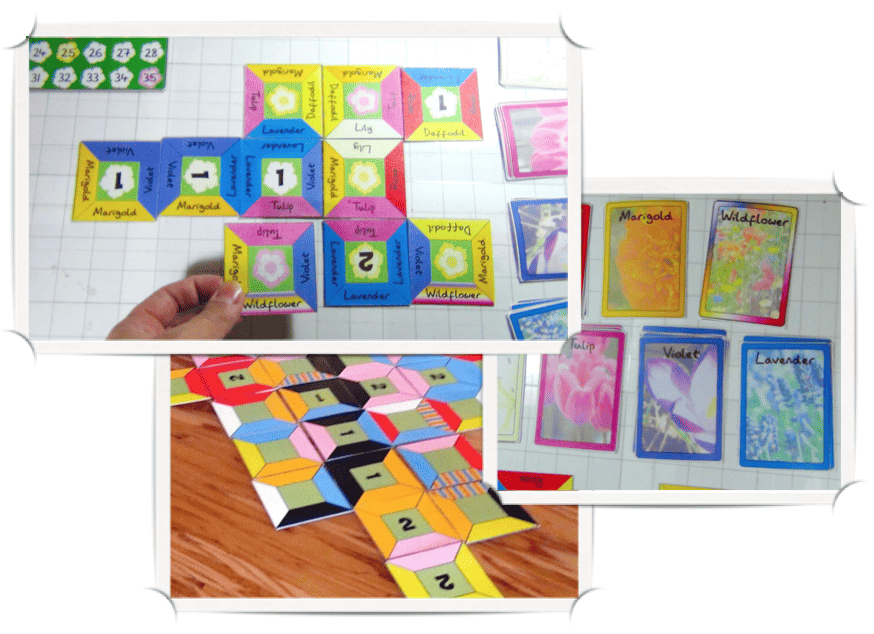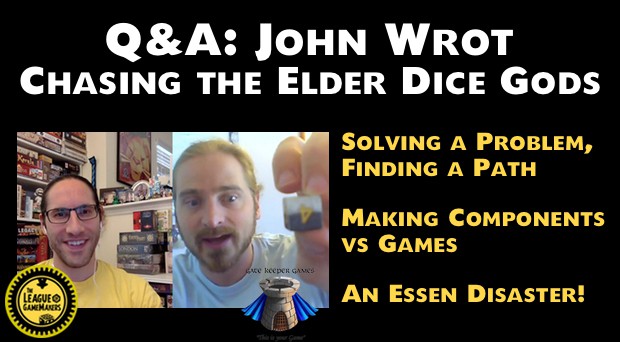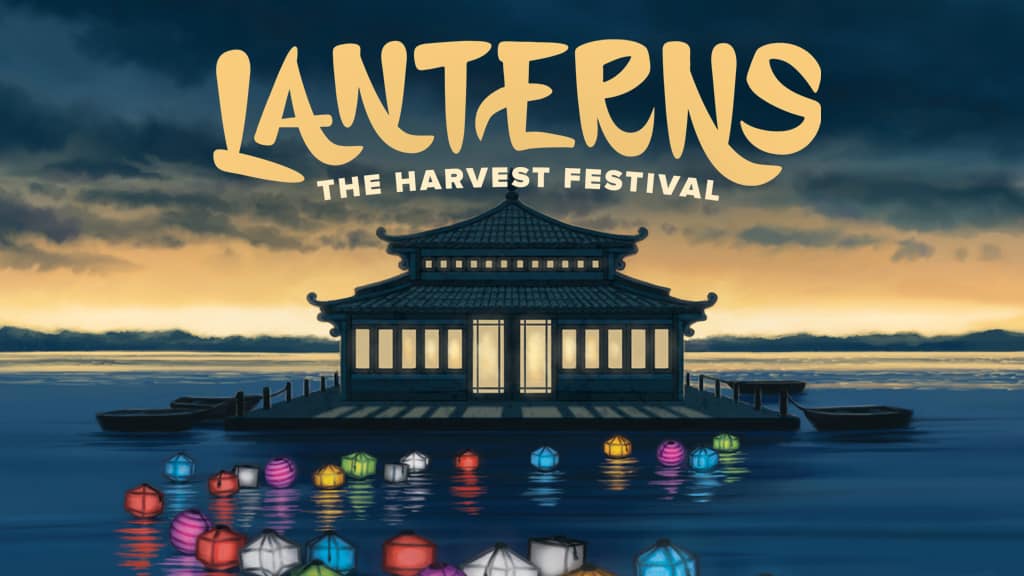
Guest post by Randy Hoyt. In his day job, Randy works on the user experience design team for a Silicon Valley startup. But at night, he designs and publishes board games. His next game, Lanterns: The Harvest Festival, is on Kickstarter now.
Introduction by Luke Laurie: Randy Hoyt has been a consistent reader of the League of Gamemakers, and frequently leaves comments and engages with members of the League in various forums. I was thrilled to get a chance to play a prototype of Lanterns with Randy at Gencon, and I must say this is a very fun game. The tale of how Lanterns was re-themed continues the League’s ongoing dialog about the interrelationship between theme and mechanics. Enjoy!
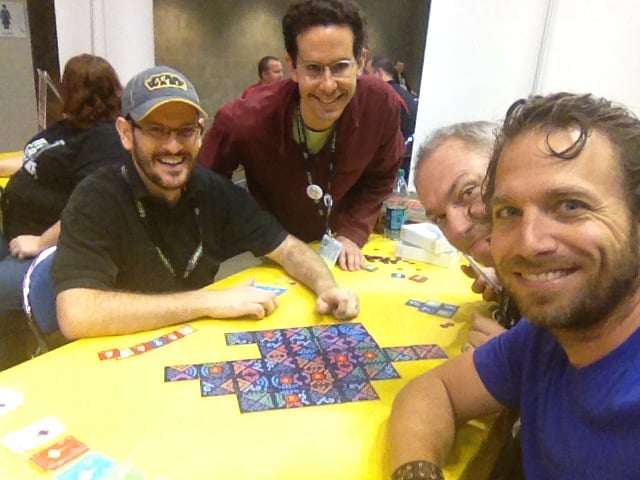
Randy Hoyt, Ben Rosset, Tom Lathos, and Luke Laurie enjoying Lanterns at Gencon 2014
PART I, MECHANICS AND FLAVOR
You may have heard that a publisher might sign your game and then make drastic changes to it, maybe even change the theme entirely. Well … that’s true! The next game we’re publishing at Foxtrot Games is Lanterns: The Harvest Festival This game was first pitched to us with a completely different theme.
In this two-part series, I’ll take you through the process of how this game was re-themed.
In this piece I’ll be referencing some of the terms introduced by Mark Major in his League of Gamemakers article Theme-vs-Mechanics-the-False-Dichotomy, so it might be helpful to be familiar with that piece. These terms helped me understand and describe the process I went through to re-theme Lanterns.
I first met Christopher Chung, the designer of Lanterns, on Twitter (@FlashForwardCo). I don’t remember how we started following each other, but (searching my email) it’s now been a year. He shares print-and-play (PnP) versions of his prototypes on Twitter, to get feedback on game play and rules. I downloaded one of these PnPs for a game called Blossom to see if it was something my son Garrett (age 7) and I would like to try. I read the first paragraph of the rulebook, which described it as a game about planting and harvesting flowers to make bouquets, and we passed on printing and playing it.
Some time later, after a conversation on Twitter about something else, Chris formally submitted Blossom to Foxtrot Games. I downloaded the rulebook, and this time I read past the opening paragraph. The way that players placed their tiles and how the cards got distributed was so unique and interesting to me. I had a feeling the game had something special, and I really wanted to play it to see if it was right.
The flower theme had gotten in the way for me personally, and I knew I would only publish it with a different theme. So I made a themeless abstract version, editing Chris’s PnP tiles in Photoshop and using Ticket To Ride cards. I played this themeless version solo a few times and loved it. I played it in person with friends, family, and strangers at my local game store, and I also set it up in Rolld20 so that I could play it online with some of our Foxtrot Games testers and developers. The game needed some development work to be great, but it was already a hit.
I asked everyone who played this themeless version about a theme, and it was constantly on my mind for weeks. Were you wiring circuits? Hacking a computer or cracking a safe? Mining an asteroid? Giving medicine to a sick patient? Our brainstorming efforts focused on narrative by considering what choices players made and trying to explain them with a backstory. (I have re-themed some of my own games at this level before: ask me about my voting game with a family vacation , deep space mission, monster-building theme sometime.) None of these theme ideas stuck: pasted-on themes felt, well, pasted on.
The key was to go down a level deeper. At work, we were doing a branding exercise for a product, and we listed off the adjectives we wanted to describe the product. I realized that a similar exercise would work here. If we re-themed the game correctly, the mechanics (the intersection of the rules and the components) would work together with the flavor to produce a theme and a narrative to created a coherent context and experience for players. I mulled over all the feedback on the mechanics: what type of experience were they creating on their own? What adjectives did players use to talk about the mechanics? Players described the game as simple and elegant. It was calming and relaxing to play. They were surprised and delighted by the richness of the decisions. They said it flowed smoothly, that they could play it over and over again.
So instead of looking for theme and narrative that explained the mechanics, I set out to find flavor that could be be described in the same way as the mechanics. I can’t quite remember when it happened — creative sparks are so hard to pin down! — but an image from the movie Tangled crossed my path at this time. (I believe I was discussing with other parents why Frozen had been a bigger cultural phenomenon than Tangled.)
From a boat floating smoothly in the water, Rapunzel watched these simple and elegant lanterns with delight year after year. This image captured perfectly the feeling that the playing the game produced, and I knew a theme and narrative woven around this could work to produce a great experience.
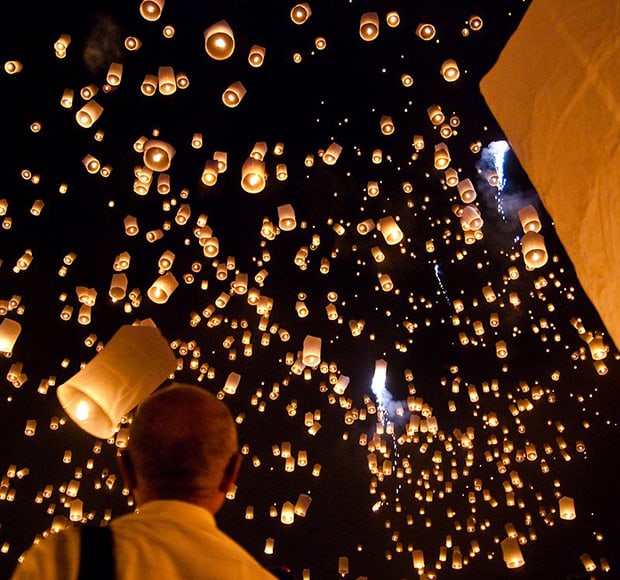
Festival image by Takeaway. CC BY-SA 3.0

With floating Chinese lanterns as the flavor and Chris’s solid mechanics in place, we signed a contract to develop and publish the game. But in many ways, the re-theming work was just getting started. We hadn’t blended the mechanics and the flavor together into a unified narrative and theme yet, and we would need those to produce the full experience we desired. I’ll explore that in Part 2.

